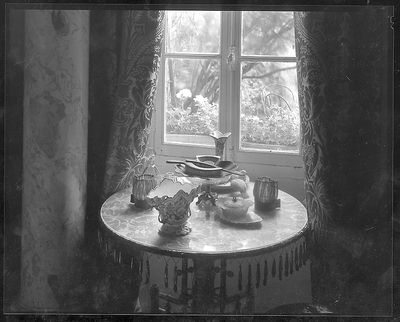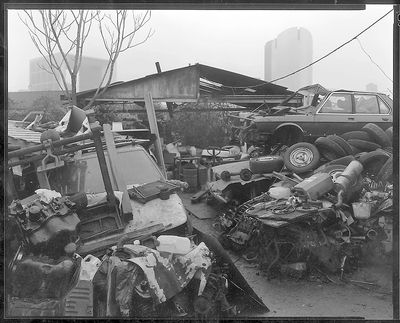Mala Gallery ZPAF-CSW, Warsaw, Pl. Zamkowy 8
May 5 to 29, 1998
------------------------------------------------------

Bogdan Konopka : RIAU DE GROS MONT (Switzerland) 14 July 1996,
Contact print from a negative of 20 x 25 cm size
Beyond time
ONTEMPORARY photography becomes today a more compound and complicated phenomenon. In this time of fast development it reaches new limits of technological perfection. Many professional photographers strive to achieve images of strikingly perfect quality. But there are also the artists who do not yield under this pressure and who execute their pictures in a traditional way employing camera, film, photographic paper and classical set of photographic processing chemicals.
Recently the Mala Gallery has already presented outstanding works of such photographers. Bogdan Konopka should be numbered among this group too. This artist does not use an enlarger to make his black and white photographs. All his pictures are contact prints of 20 x 25 cm (8 x 10 inches) size. The most distinctive feature of these photographs is the fact that they are produced from an unusually big negative. Bogdan Konopka, like the photographers from the group from Jelenia Gora - Wojciech Zawadzki, Ewa Andrzejewska and Marek Liksztet, is loyal to the method of contact printing. This method despite imposing on photographers some strict formal limitations brings us closer to the very core of photography, it is photography itself in its pure, non-manipulated form. The traces left by the rays of light on a film are faithful recording of what the artist has selected and accepted within camera's angle of view. This photographer's choice after being registered on a film cannot be cropped in order to emphasize some other values than these present in front of the camera during the time of exposure. These photographs contain everything - time, light, composition and psychosomatic state of the artist.
Bogdan Konopka : ARBONNE LA FORET, 20 May 1997
Contact print from a negative of 20 x 25 cm size
At the first glance it seems that the flow of time was frozen in these very aesthetic and consciously composed images in the right moment. But this moment is very static, there are no dramatic events in Konopka's photographs, his camera does not catch any "decisive moments". The fragments of reality of almost still life quality emerge from a dark background. We can observe on these photographs various grades of saturation of image with light just to find eventually, in most cases in the central area of the picture, the lightest tones which constitute objects like e.g. an open window, lit street lamps or radiating horizon. Artist's emotions became obvious, his poetic interpretation of pulled out of their environment, partly trite but also mysterious places is impregnated with melancholy and principally is marked by struggling with passing of time. Artist accentuates this struggle with time also when he photographs open areas. It is quite possible that these photographs are inspired by the Paris landscapes of Eugene Atget. This relativistic approach to the question of time can be found in almost all photographs of Konopka. It does not matter if he photographs a fragment of the nature (trees, forest, creek), urban landscape (street in Anger, dumping ground outside Paris), interiors (Clayrou, Arbonne la Foret, Arles). The artist's dates these photographs. If he would not do that no one could say if they were made twenty years ago or just recently.
The works of Bogdan Konopka despite of this relativistic treatment of time are marked by outstanding poetic quality of photographic image. Andrzej Saj in the text accompanying one of Konopka's exhibitions calls this feature photogeny. Particularly the photographs of interiors are according to him "a transformation of non-obvious interior, they are proof of poetic sensitivity, echo of metaphysical questions" 1). The interiors which Konopka has photographed last year in Nice were printed in the interesting photographic book which includes the introduction written by Xavier Girard2). The critic compares the photographs taken by Konopka with the Seicento paintings with their outstanding effects in relations between black and white. This greyness so hard to achieve in photography also is a proof of the technical skill of the artist. It has a symbolic meaning too. It somehow freezes the incessantly passing time, fixes it within photographic image and endows it with a gentle reflection on transitory nature of things.
The question of passing of time, a phenomenon that accompanies photography like a shadow, is constantly present in the recent works of Bogdan Konopka.
Marek Grygiel
1) Andrzej Saj, The "Greyness" of Endurance - on photogenic works of Bogdan Konopka, FF Gallery, Lodz, May 1995
2) Xavier Girard, "Nice, dix photographes et une ville", Gregoire Gardette Edition, Nice, 1997
Bogdan Konopka : COURBEVOIE - LA DEFENSE, 18 January 1997
Contact print from a negative of 20 x 25 cm size
- B. Konopka: "La ville invisible, Paris", Galeria FF, Lodz (Poland), 1995
- Other exhibitions in "Mala Gallery"
Copyright © 1997-2012 Marek Grygiel / Copyright for www edition © 1997-2012 Zeta-Media Inc.
e-mail: fti@zeta-media.com


